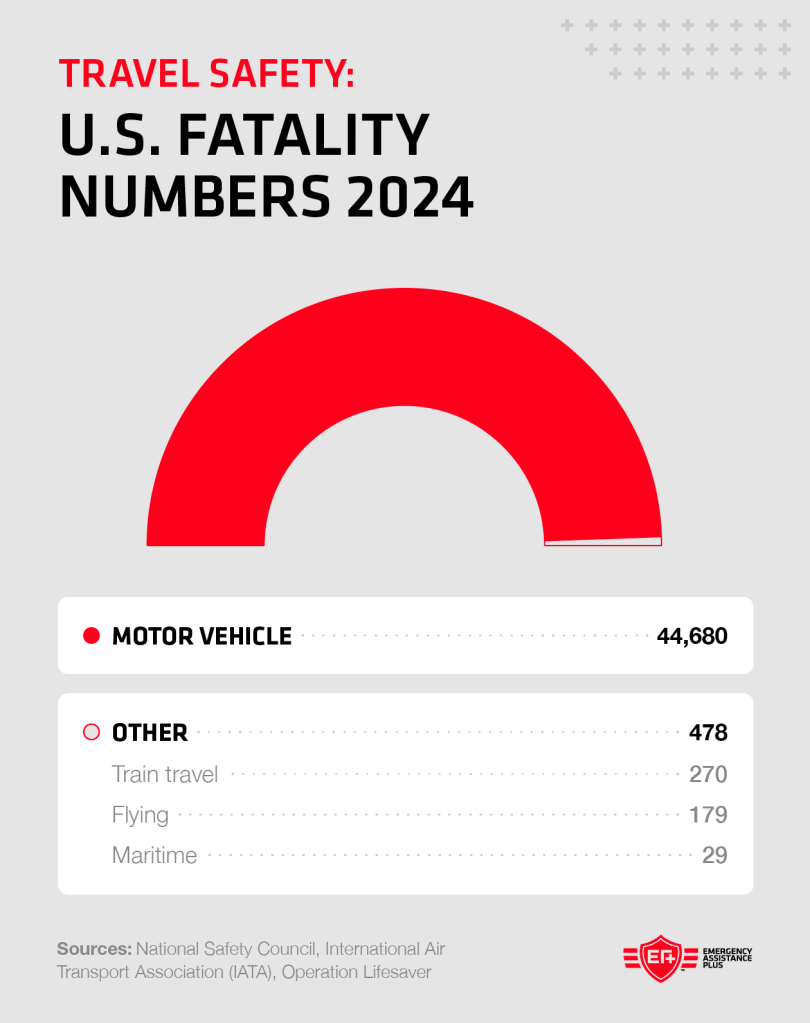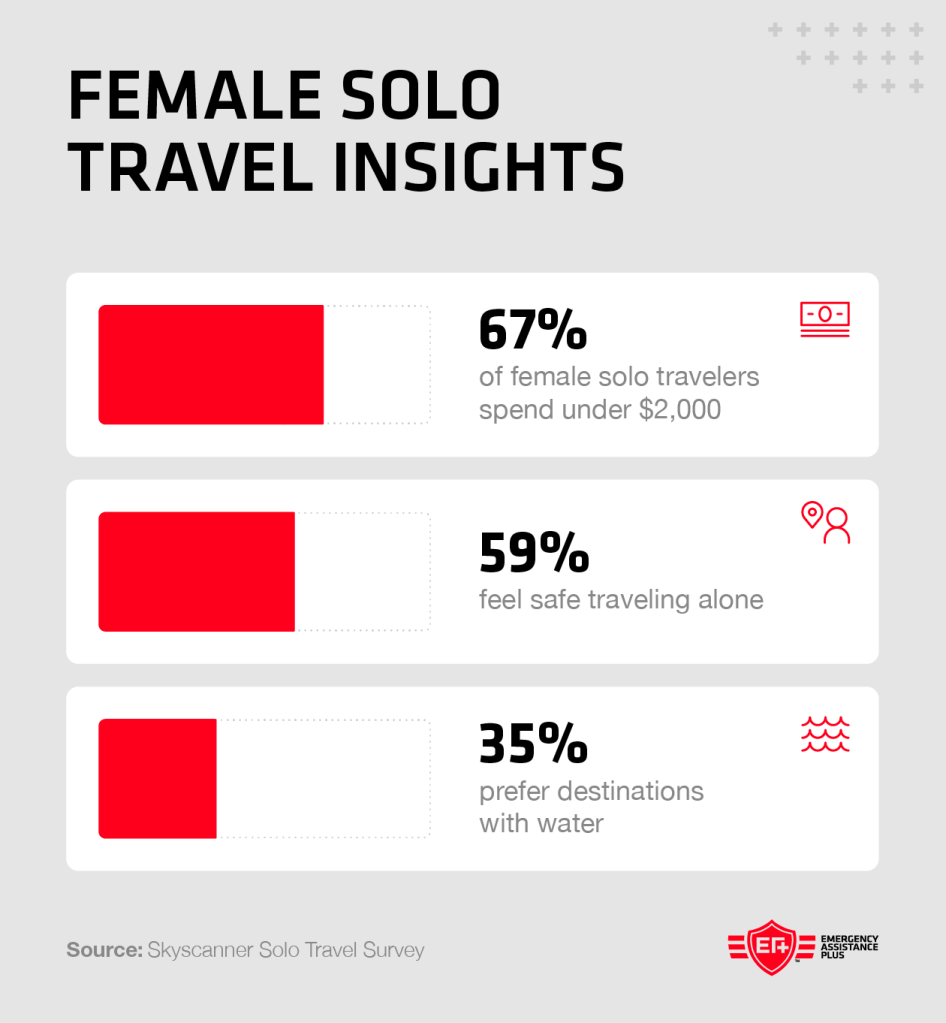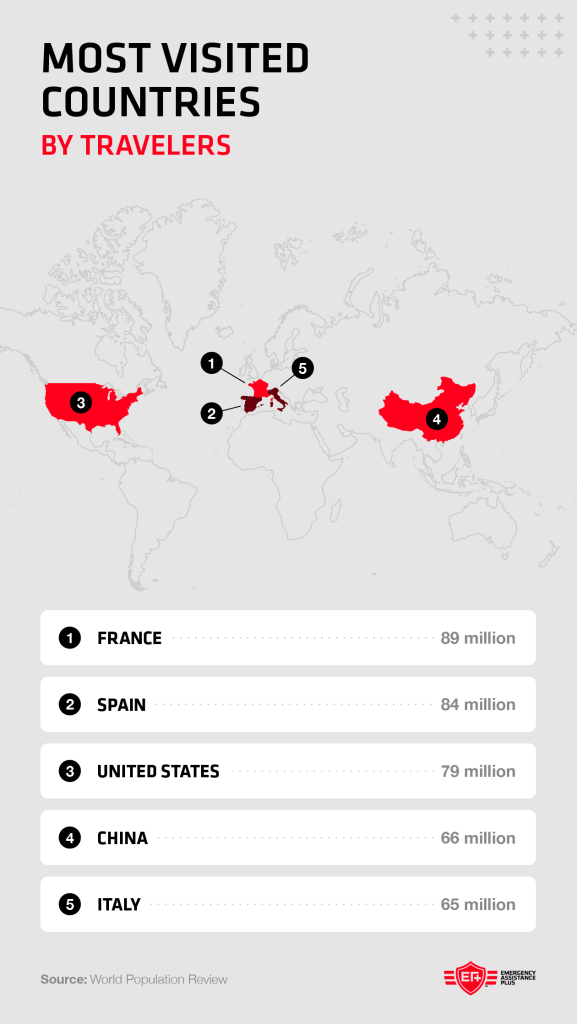Travel Tips
Check out what’s new in travel safety for 2025: Flying is still the safest way to travel, and AI is making trips even safer with useful features like translation, tracking, and real-time alerts.
From 2023 to 2024, there has been a concerning 60% increase in death-related incidents among travelers. This surge underscores the heightened risks that travelers face, emphasizing the critical importance of prioritizing safety measures while abroad.
As an established travel assistance membership plan, Emergency Assistance Plus® (EA+®) has extensive experience supporting travelers during unforeseen medical emergencies.
We spoke with Bryanna Moore, Senior Product Manager, Dr. Michelle Nathan, MD FAAEM, Chief Medical Officer, and Johanna Hartnett, Global Security Services Manager, who are key experts in travel safety at EA+ to gain insights on the trends that impacted travelers in 2024 and what’s on the horizon for 2025.
Although late 2024 and early 2025 saw increased media coverage of airplane accidents, air travel remains the safest mode of transportation compared to road, rail, and maritime travel, such as cruising.
In 2024, the global aviation accident rate was 1.13 per million flights (one accident per approximately 880,000 flights). This is an improvement over the five-year average of 1.25 but a slight increase from the 1.09 recorded in 2023.
This slight increase in the accident rate may be linked to a 10.4% rise in air travel traffic year over year. It is still lower than the safety statistics for other forms of travel.

This data underscores the relative safety of air travel, but traveler concern remains a factor, as Senior Product Manager Bryanna Moore states:
“Travelers are increasingly researching airline safety records before booking flights, and more people are purchasing coverage that includes emergency evacuation and flight cancellation.”
For peace of mind regarding medical emergencies and emergency evacuation, look into plans like travel assistance to cover costs, or if you’re worried about flight disruptions, look into flight insurance.
Compare plansWith a current value of $482 billion in 2024, the solo travel industry is experiencing significant growth, projected at a 14% CAGR between 2025 and 2030. Notably, women are a key demographic in this market, accounting for 54% of solo travelers.
This strong female presence in the solo travel market is further reflected in traveler sentiment, with 59% of female solo travelers feeling safe traveling alone, possibly due to access to safety resources, growing empowerment, and better travel planning.

Outside of solo travel, the rise of female-friendly accommodations, tour groups, and trends like van life offer control and independence, which adds to this sense of security. Maintaining situational awareness is crucial, especially when driving alone. Particularly in snowy conditions, travelers should actively seek and apply winter driving tips to stay safe.
While solo travel demonstrates a positive perception of safety, it’s important to acknowledge broader trends in traveler risk mitigation in 2025. As Moore states:
“Conflicts in the Middle East, Ukraine, and Taiwan have increased risks for travelers, prompting greater caution around geopolitical tensions, natural disasters, and even cyber threats that can disrupt travel plans.
As a resource, the U.S. Department of the Treasury offers a comprehensive list of Sanctions Programs and Country Information to help travelers stay informed if they are planning on traveling abroad.”
“There’s growing interest in travel assistance and insurance plans, with more travelers purchasing [protection] that includes emergency evacuation, trip cancellation, and protection against disruptions or health risks,” says Moore.
The rising interest in travel protection is reflected in EA+’s membership trends. From 2021 to 2024, membership in travel assistance programs grew overall. The steady growth over time reinforces travelers’ continued prioritization of protection amid escalating global health risks.
As concerns over travel disruptions and health risks grow, more travelers are securing protection for eventualities like flight cancellations or medical emergencies. According to an NMSC report, 36% of travel protection is for medical coverage.
In 2024, 15 norovirus outbreaks on cruise ships led to 1,894 passengers and 245 crew members becoming sick. These outbreaks coincided with a global rise in illness reports of influenza, RSV, and other infectious diseases.
This broader trend has strained healthcare systems, a pattern reflected in our internal data. From January to March 2024, illness-related membership cases surged by 26%.
Looking ahead, this issue of illness-related travel disruptions is likely to persist in 2025 and beyond, impacting how travelers prepare for trips and what they prioritize. As Dr. Michelle Nathan, MD FAAEM, Chief Medical Officer, states:
“Recent outbreaks—such as Mpox globally, measles in Europe and the U.S., and yellow fever in parts of the Americas—have heightened traveler awareness around health risks.
As a result, more travelers are engaging in pre-trip planning, asking about available medical care, medications, and health services at their destinations. It’s essential to research your destination for disease concerns, vaccination requirements, and local resources for medical care before you go.”
Travel assistance plays a useful role in supporting travelers affected by medical emergencies abroad, including hospitalization due to severe outbreaks like norovirus or general illnesses like traveler’s diarrhea. It helps protect against medical expenses, evacuation (if needed), and logistical support for managing cancellations or delays due to health issues.
Learn moreHumetrix’s AI-powered app at the Paris 2024 Olympics demonstrated the effectiveness of AI language translation in emergency care. By translating patient data into 25 languages, the app ensured rapid communication, optimized resource use, and provided equitable medical assistance to attendees.
This aligns with a JAMIA case study, which, while acknowledging AI translation technology’s ongoing development, highlights the potential to enhance face-to-face communication, improve care quality, and address health disparities.
Both cases underscore the importance of utilizing resources that bridge language barriers to optimize patient care in diverse settings.
Beyond language translation, technology can enhance vacations through real-time location tracking, contact tracing, and AI-driven safety alerts when used correctly. This use of technology could increase traveler control and security in 2025 and beyond, as Global Security Services Manager Johanna Hartnett states:
“Real-time communication capabilities allow travelers to immediately alert management in case of an emergency, while management can track their progress through the itinerary. This technology has significantly reduced risk landscapes and increased comfort for travelers in a variety of situations.
For example, it can assist a study-abroad student walking home alone in a new city or a caravan traveling through the SAHEL.”
In 2025, travelers consistently find Canada, Japan, New Zealand, Portugal, and Iceland exceptionally safe. These countries benefit from strong social systems, effective governance, and geographic factors that contribute to low crime rates.
This search for security is driving certain travel choices, as Moore states:
“Travelers are increasingly seeking destinations and travel advisors who can offer more personalized and safer travel experiences for their families. Safety concerns have led many families to prefer all-inclusive resorts, private vacation rentals, and other accommodations that offer more controlled environments.”
These five countries offer reliable infrastructure and top-notch healthcare, significantly reducing medical risks during your journey. Recent aviation safety data also highlights them as safe places to travel.

Iceland is a Nordic island country known for its dramatic landscapes, including volcanoes, geysers, hot springs, and lava fields. It consistently ranks as one of the safest countries in the world due to its remarkably low crime rate, strong social welfare system, and culture of trust.
Japan is an East Asian island nation known for its unique blend of traditional culture and modern technology, including bustling cities, diverse natural landscapes, and serene temples. It is widely recognized as one of the safest countries in the world.
New Zealand is a South Pacific island nation famous for its stunning natural terrain, including majestic mountains, pristine lakes, and dramatic coastlines, and a thriving adventure tourism industry. It is also known as a very safe country for travelers.
Portugal is a Southern European country celebrated for its rich history, vibrant culture, and picturesque coastal towns. It is also generally considered a very safe country for travelers.
Canada is a North American country renowned for its vast wilderness, multicultural cities, and friendly citizens. It maintains a strong record of safety for tourists.
The global travel industry has made a strong recovery since the impact of COVID-19. As tourism levels continue to rise, here are some key insights—some reflecting industry-wide trends, others specific to EA+, especially in areas like health and safety.

The travel industry is ever-evolving, with travel safety trends frequently changing. To lower accident risks and ensure a safe journey, travelers of all ages, including senior travelers, need to stay informed about their plans before and during their trip.
EA+ is a proactive annual travel assistance membership designed to assist you in a medical emergency. With safety risks varying by destination, having a reliable protection partner is essential for peace of mind, helping you feel safe no matter where you travel.
Enroll todayFirst-party data is collected from member cases, specifically focusing on date, type of incident, location of occurrence, transport details, and associated costs. This data is used to identify and support data trends related to accident, injury, death and other incident patterns, with a strong emphasis on maintaining client data privacy.
Costs represent the service expenses, distinct from the annual membership fee, which covers access to those services when an incident occurs.
To determine the safest travel destinations, we analyzed crime rates, Global Peace Index ratings, and life satisfaction across numerous countries using data from the Global Peace Index, Organisation for Economic Co-operation and Development (OECD), and World Population Review. Countries were compared based on these factors, with each metric contributing to an overall understanding of safety for travel.
The four-tier U.S. travel advisory system helps travelers evaluate risks before visiting a country. Issued by the U.S. Department of State, these advisories assess safety concerns such as crime, terrorism, civil unrest, health risks, and natural disasters to guide informed travel decisions.
The levels include:
The safest ways to travel around the world are commercial flights and train travel. Both have low accident rates and strict safety protocols.
Air travel is statistically the safest mode of transportation, with an exceptionally low accident rate per mile. This is largely attributed to rigorous safety standards, advancing technology, and extensive pilot training.
The safest places to go as a solo traveler are Iceland, closely followed by Japan and New Zealand, all known for their low crime rates, friendly locals, and safe environments.